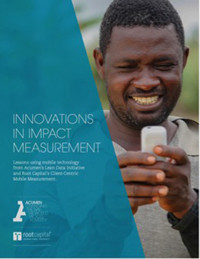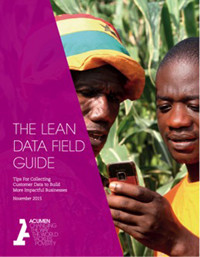At time when “big data” is all the rage, the leaders and funders of social sector organizations are asking some big questions about the challenge of gathering and using data on an appropriate scale. How can social enterprises and nonprofits generate and then leverage data about the real, on-the-ground impact that their work has on customers and beneficiaries? And more to the point, how can they do so cheaply—without undertaking a long, complex, and potentially overwhelming research project? Leaders at Acumen, an organization that invests in social enterprises, have developed a model that they call “lean data.” In this model, an organization gathers ready and relevant impact data by combining the use of mobile technology with careful survey design. Acumen launched its Lean Data initiative in early 2014, and since then it has tested the model in collaboration with a wide range of its funded companies. In “The Power of Lean Data,” a feature article that appears in the winter 2016 issue of SSIR, Sasha Dichter, Tom Adams, and Alnoor Ebrahim provide an overview of those efforts.
To supplement the article, we present two items that Acumen has produced to support the Lean Data initiative. We share this material in its original form and with the permission of Acumen.
Acumen is not alone in exploring the potential for gleaning social impact data through the use of mobile technology. Root Capital, an organization that finances small and growing agricultural businesses in Africa, Asia, and Latin America, has developed a model that it calls Customer-Centric Mobile Measurement. Since 2012, Root has collaborated with its clients to study the impact of their work by deploying tablet computers and mobile survey software. This year, Acumen and Root Capital joined together on a report that summarizes lessons that these organizations have gained through their respective initiatives. Here, we invite readers to download and consult the report.
Innovations in Impact Measurement

“Thanks to the ubiquity of cellphones and dramatic improvements in technology—inexpensive text messaging, efficient tablet based data collection and technologies like interactive voice response—we are in the position to quickly and inexpensively gather meaningful data directly from end customers of social enterprises. Moreover we can collect this data in ways that delight and engage customers and provide the information social enterprises need to optimize their businesses.”—from the report
Download the complete document here.
In their article, Dichter, Adams, and Ebrahim discuss the rationale behind the lean data model and present examples of social enterprises that have benefited from adopting it. But how can social sector practitioners put the model into practice? Members of the Lean Data team at Acumen created a step-by-step guide to the nitty-gritty work of designing a lean data project. It covers everything from choosing a survey technology to drafting survey questions to taking action on the basis of survey results. Here, we invite readers to download and use this document.
The Lean Data Field Guide

“The [lean data] approach has two main elements: a shift in mindset away from reporting and compliance and toward creating value for a company and its customers; [and] the use of methods and technologies for data collection that emphasize efficiency and rapid response while still achieving a sufficient degree of rigor.”—from the field guide
Support SSIR’s coverage of cross-sector solutions to global challenges.
Help us further the reach of innovative ideas. Donate today.
Read more stories by SSIR Editors.

